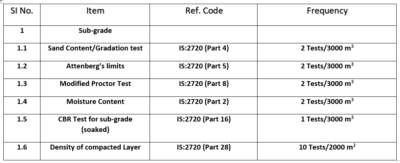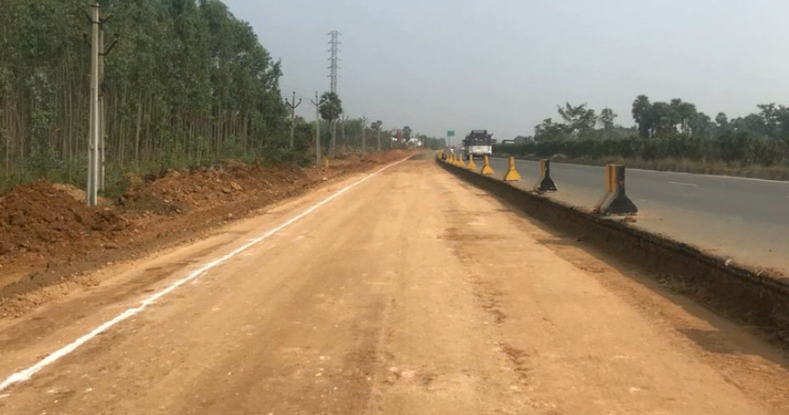Subgrade is the main part of the any earth work .They are widely used in road, railway and airport runway construction but here we will discuss sequence wise working methodology for the earthwork in subgrade for any highway work.
- Scope of Work
- Reference Documents.
- Setting Out.
- Selection of Material & Borrow areas.
- Equipments.
- Methods of Operation.
- Quality Control.
- Work Safety
- Environmental Safety
1.0 Scope of Work:-
The work shall consist of Construction of Sub-grade with approved and specified materials obtained from approved borrow areas or suitable material obtained from roadway excavation and drain excavation and in accordance with clause 305 of MORT&H specification.
2.0 Reference: –
Reference Documents:-
- Ministry of Road Transport & Highway Specifications.
- Technical Specifications
- Relevant contract drawings.
- IS 2720 Codes.
3.0 Setting Out: –
After completion of site clearance/embankment the limits of sub-grade shall be marked by fixing pegs on both sides at regular intervals. The chainage boards and working bench mark shall be set outside the limits of construction areas.
4.0 Selection of Material and Borrow areas: –
4.1 Material:
The material used in Sub-grade shall be soil, moorum, gravel, a mixture of these or any other material approved by the Engineer. It shall be free from logs, stumps, roots, rubbish & any other material detrimental to the stability of structure. The material for sub-grade shall be obtained from the approved source with preference to the material becoming available from nearby roadway excavation or any other excavation under the contract. The material requirements shall be in accordance with clause 305.2 of MORT&H.
4.2 Borrow Material:
Samples should be taken from the known borrow area & to be tested as per IS 2720 for the suitability in use in embankment as per project specification. On confirmation of the suitability material the area shall be properly demarcated and satisfy the clause 305.2.2.2 or project specification
5.0 Equipments: –
The following equipments shall be carried out for the Sub-grade Construction. If desired the contractor shall demonstrate the efficacy of the type of equipment to be used, before commencement of work.
- Hydraulic Excavator
- Dozer
- Dumper (Tipper Trucks)
- Motor Grader
- Vibratory Roller
- Water Tanker
- Tractor Trolleys
- Survey Kit
6.0 Method of Operation: –
- After completion of embankment, the limits of sub-grade shall be marked by fixing pegs at regular intervals before commencing the earthwork. Construction toe line shall be more than the design toe line for proper construction of the edges.
- The Embankment top shall be levelled to facilitate placement of first layer of Sub-grade, scarified, mixed with water and then compacted by rolling so as to achieve minimum dry density as specified in the modified Technical specification. Sub-grade treatment specified for Sub-grade shall be carried out as per approved drawing. Unsuitable material occurring in sub-grade foundation shall be removed as per direction and approval of the Engineer and replaced by approved materials laid in layers and suitably compacted to the required and specified degree of compaction. Excavation at approved borrow areas shall be carried out with excavator and transportation of excavated material shall be done by dumpers/ tractor trolley.
- Maximum Dry density of borrow area soil shall be determined, and the soil shall be tested for dry density, if found less than 97% of M.D.D., the layer shall be scarified mixed with required quantity of water and compacted with soil vibratory roller to achieve minimum required specified dry density.
- For construction adjacent to the existing embankment a continued, horizontal benching 300 mm wide or as per drawing shall be provided in the existing embankment.
- The sub-grade material shall then be spread in layers not exceeding 250 mm compacted thicknesses or as per direction of the Engineer over the entire area with the dozer and finished by a motor grader. When the existing embankment to be widened continuous horizontal benches shall be cut out into the old slope to ensure adequate bond. Where water is required to be added the same shall be sprinkled from a water tanker fitted with sprinkler, uniformly on the surface but without flooding and shall be mixed thoroughly in soil by blending or harrowing until uniform moisture content is obtained throughout the depth of the layer. If the material delivered to the roadbed is too wet, it shall be dried by aeration and exposure to the sun till the moisture content is accepted for compaction.
- The compaction shall be done with the help of Vibratory Roller of 8 – 10 Ton static weight with plain or pad foot drum or heavy pneumatic tyred roller of adequate capacity capable to achieve required compaction. Compaction trial shall be carried out on a suitable stretch to determine the no. of passes required for particular type of soil, dumped for sub-grade, to achieve densities specified in the table 300-2 of the Technical specification. Based on the trial actual compaction will be carried out with required no. of passes of Vibratory Roller until the specified density is achieved. Rolling shall progress parallel to the centerline of the road uniformly overlapping each preceding track by one-third width. Rolling shall be continued till the specified density is achieved as per table 300-2. In case specific compaction is not achieved the material in the soft area shall be removed and replaced with approved material. Densities shall be tested by sand replacement method / nuclear density gauge.
- Subsequent layers shall be placed only after the finished layer has been tested as per the clause 903.2.2 and accepted. The top levels of the sub-grade shall be checked with reference to the longitudinal and cross profile of the road as per drawing to keep the variation within tolerance limit as per table 900-1. or as per standard specification.
7.0 Quality Control:-
Minimum compaction for sub-grade layers is 97% of modified proctor value of project specification.

8.0 Work Safety:-
8.1 During construction of widening works, adequate safety and traffic signs shall be installed adjacent to the road shoulders to protect the ongoing works as per location specific safety plan.
8.2 For locations where the dumping of embankment materials by tippers are performed from the road shoulder, a minimum of 2 flagmen with reflective vests and holding a red flag each be deployed to control the traffic which may be affected by the unloading operation.
8.3 All locations adjacent to existing road where embankment construction is in progress shall be provided with safety and road signs.
8.4 No machines or equipment’s shall be permitted to remain on the existing road or shoulder unattended at all times unless it is properly protected and secured in a safe manner.
8.5 The Safety Officer shall make frequent patrols along the highway to ensure that the safety equipment and signs are operational at all time.
8.6 Trucks sometimes fall over a tip head because the driver backs over the edge or the edge collapses under the weight of the truck. A protective berm or timber baulk should be used. Alternatively, a signalman should be deployed in order to avoid this possibility.
8.7 When excavating trenches, place the excavated material at least 600 mm clear of the edge, where there is no danger of it falling back into or collapsing the side of the trench.
9.Environmental Safety: –
a.Nearby streams, water courses, lakes, reservoir shall be protected from contamination by the soil erosion from areas exposed during excavation by constructing temporary berms, dykes, sediment Basins, slopes, drains & by the use of temporary mulches, seeding or other control devices.
b.Vehicles tracks shall be kept moist to prevent flying of dust particles with the vehicle movement.

